MLB’s free agent class bolstered by strong Japanese, Korean options

The market for MLB free agents from Asia has been weak in the last few offseasons. That’s not the case this time around.
[sc name=”kyle-newman-banner” ]The 2020-21 MLB free-agent class is widely considered to be weak. Outside of Trevor Bauer, George Springer, and J.T. Realmuto, there’s not a lot out there. Even the second-tier options would normally be third-tier choices.
Luckily for MLB teams, this appears to be a stacked market in Asia. After a few years with limited options that have mostly struggled, see Shogo Akiyama and Yusei Kikuchi, 2020 is different.
An elite Japanese pitcher and a top Korean shortstop top the market, but they’re not the only ones who can make an impact.
Tomoyuki Sugano, RHP, Yomiuri Giants
History
Sugano is a rare breed of Japanese pitcher who went to college before being drafted. Still, he dominated at the collegiate level and became the first pick of the Yomiuri Giants.
In his rookie year, Sugano proved to be a future star in the league. He really made his mark in the playoffs winning the Climax Series MVP, equivalent to the NL/ALCS MVP award. Sugano was also named an All-Star for the first of what would be six straight seasons.
From 2013-2018 Sugano won a Central League MVP, equivalent to AL/NL MVP, two Sawamura awards, equivalent to Cy Young, three Gold Gloves, and the triple crown. In 2018, Sugano threw a no-hitter in the Climax Series. Sugano had an ERA below 2.50 in five of those six seasons; only his rookie season was higher.
In 2019, Sugano all of a sudden saw a decline in his production. His ERA jumped to 3.89, he threw just 136.1 innings, and allowed 1.3 HR/9, all of which were career-worst numbers. He seemed to decline as he hit 29 years old.
He bounced back in 2020 with another phenomenal season. This past year Sugano had a 1.97 ERA, had 8.6 K/9, and just 1.6 BB/9. He found himself again and still appears to be at the top of his game.
Stuff
Sugano has a four-pitch mix. He throws a four-seam fastball and a sinker, both sit 90-93, a major dropoff from early in his career when he threw 96-98. It’s still an effective pitch due to its late movement.
Sugano’s best secondary pitch is his slider, which grades out as plus. He also throws a forkball and a curveball, both of which grade out as above-average offerings.
What MLB scouts will love most is Sugano’s control. Over his career, he has just 1.8 BB/9. He’s going to throw strikes, and for the most part, he keeps hitters off his stuff.
Unlike other Japanese pitchers, Sugano has shown he’s able to limit home runs. He also led the Central League in strikeouts twice.
Conclusion
Had Sugano come over to MLB three or four years ago, he would have been on the same level as Yu Darvish and Masahiro Tanaka. Instead, at the age of 31, Sugano is a lesser-known option.
Sugano isn’t likely to be a frontline pitcher in the majors, but he could be a No. 2 or 3 starter in a rotation. The question is how long he’ll last? Would an MLB team be willing to give him a four-year deal that takes him through his age 34 season?
It’s a shame. Sugano could have been a frontline starter had he come over sooner. Now he’ll likely get just one contract that undervalues him.
He makes a lot of sense for both the New York Mets and New York Yankees if they lose out on the likes of Trevor Bauer and Masahiro Tanaka.
Ha-Seong Kim, SS, Kiwoom Heros
History
Ha-Seong Kim was a dominant high school baseball player. It led to him being the 29th selection in the 2014 KBO Draft by the Kiwoom, then Nexen, Heros.
He made his debut that year, playing in 60 games. It was rough, he slashed just .188/.298/.396. Such is life as an 18-year-old playing in one of the best professional baseball leagues in the world.
By his second season, Kim had figured it out. He’s dominated Korea since. He’s slashed .294/.373/.493 over his career in Korea. In 2020, he had his first 30 home run season. That came after he stole 30 bases in 2019.
Most impressive is Kim’s defense. He won the KBO Gold Gloves at shortstop in both 2018 and 2019.
Tools
Kim’s best tool may be his defense. His Gold Gloves show his elite defensive ceiling, though defense is difficult to project from league to league. With different hard-hit rates, pitching styles, and most importantly, stadiums, it’s difficult to project. Still, there’s enough proof to say that Kim will be at least an average defensive shortstop.
He has above-average to plus speed that’s helped him be a strong base stealer to this point in his career. That’ll also help his defense.
It’s hard to project offense from the KBO to MLB. The KBO is arguably the most offensive baseball league in the world. It’s true that Kim has dominated that league, but so have others who made the jump. It’s a difficult one to make, to say the least.
The biggest dropoff is usually in power. So while Kim was a 20-30 home run guy in Korea, he likely won’t be that guy in the majors. He’ll more than likely be a 10-20 home run guy.
The one thing that we know will carry over is his ability to get on base. Kim is a patient hitter with a good eye. He doesn’t strike out all that often and he’s routinely among the walks leaders in the league.
His tools would be comparable to a top-100 prospect.
Conclusion
Teams don’t often get the chance to jump at a 25-year-old shortstop with a proven professional track record often. Kim is going to grab a ton of interest because if he hits, then teams are going to get a star shortstop on an incredibly cheap deal with the potential to have him man the position for a decade.
Kim’s going to need time to adjust. He’s not going to dominate MLB immediately. He might even need time in Triple-A before he makes the jump to the majors.
Still, he’d be a strong get for a team in a rebuilding phase or looking for a top-tier second option like the Athletics, Orioles, or Tigers. The Yankees could make sense if they lose D.J. LeMahieu in free agency.
Kohei Arihara, RHP, Hokkaido Nippon-Ham Fighters
History
Kohei Arihara began his career in Japan in 2015. He was named the Pacific League Rookie of the Year, equivalent to AL/NL Rookie of the Year. His numbers didn’t get much better from there, though.
Over his first four years, he only had one season with an ERA under 4.10. His strikeout numbers were dreadful, though he was able to avoid walks. He was prone to giving up hard contact. Home runs were a big issue for Arihara for a while.
In 2019 something clicked. He had the best season of his career, a 2.46 ERA, 0.8 HR/9, 8.8 K/9, and 2.2 BB/9. He was among the best pitchers in Japan.
He wasn’t quite able to replicate that success in 2020, though he did continue to pitch well. He had a 3.46 ERA, 0.7 HR/9, 7.2 K/9, and 2.0 BB/9.
He doesn’t have the track record that Sugano has, but he appears to be a pitcher on the rise, hoping to make the jump to MLB at the top of his game. Not a bad decision for the 28-year-old.
Stuff
Arihara throws a fastball that sits in the low 90s. It doesn’t have a great spin rate or a late movement, though he’s endeavored to change that. He’s started throwing more two-seam fastballs the past two seasons to great results.
Arihara’s splitter is his best secondary pitch, and it’s nasty when it’s on. It sits in the high 80s, just a few MPH slower than his fastball, with serious late movement. When he has it working, it’s almost unhittable.
Arihara’s most common secondary pitch is his changeup, which has seen massive improvements over the last two seasons. It’s now considered one of the best changeups in all of Japan.
He also throws a slider that sits mid-80s and a curveball. Neither pitch is considered better than average.
Arihara’s only plus pitch is his splitter. His fastball and changeup are above-average.
Conclusion
It’s hard to predict how MLB is going to view Arihara. It’s clear that he would likely be a back of the rotation starter if teams went that route.
While he has a five-pitch mix, a lot of it isn’t major league caliber. Not to mention his numbers are worse than the typical Japanese free-agent pitcher. As a result, it’s difficult to see MLB teams viewing him as a starter long term.
For example, Arihara is often said to be in the same tier as Yusei Kikuchi. Kikuchi had a career 2.77 ERA and 8 K/9 in Japan. In comparison, Arihara has a career 3.65 ERA and 6.8 K/9. So, it’s great that he’s improved over the last two seasons, but his production is still lagging behind the usual Japanese import. It’s not like Kikuchi has found success in America himself; in his two seasons with the Mariners, he has a 5.39 ERA, 5.17 FIP, 3 BB/9, and 7 K/9.
However, it wouldn’t be a surprise to see a team take a shot on him as an interesting relief pitching option. They could whittle his arsenal down to his fastball, splitter, and his next best-offspeed pitch and turn him into a multi-inning weapon out of the pen.
That way, his stuff doesn’t get exposed after multiple times through the order. It’ll also help that his stuff would play up out of the bullpen, making his fastball a more viable weapon.
It’s hard to predict how the market views Arihara, but it’s possible he doesn’t sign with anyone this offseason and returns to Japan. If he’s open to moving into a bullpen, it’s possible that a third of the league jump at the opportunity for a potentially cheap multi-inning reliever with upside.
Haruki Nishikawa, CF, Hokkaido Nippon-Ham Fighters
History
Haruki Nishikawa came to the NPB right out of high school. He made his debut in 2011 at the age of 19. He wasn’t overpowered. He slashed a cool .261/.323/.355. Not the flashiest slash line, but impressive for a 19-year-old.
Since then, Nishikawa has only gotten better. He’s been particularly impressive the last five seasons. During that span, he’s been named an All-Star twice, won three Gold Gloves, was the stolen base champion twice, and was named to the NPB’s best nine twice.
It’s safe to say that he’s become one of the premier center fielders in all of Japan. He’s coming off the best season of his career in 2020. He hit .306/.430/.396, stole 42 bases, and played exceptional defense.
Tools
Nishikawa’s best tool is easily his speed. It grades out as plus-plus and will make him one of the best base stealers in MLB from the first day he steps on the field. He may not steal bases at an 84% clip like he did in Japan, but expect Nishikawa to top 30 steals easily.
His speed also helps him to be an average to above-average defender. Nishikawa has played all over the field. During his time in Japan, he’s played first base, second base, third base, shortstop, left field, center field, and right field. However, he’s played the outfield almost exclusively since 2015.
All that moving around has hurt Nishikawa’s natural instincts in the field. He’s been able to make up for that with speed to this point, but as he ages, that won’t stay the same. On the flip side, his instincts will continue to improve the more he plays in one position. That should allow him to stay average to above-average as he ages.
Offensively Nishikawa will not provide any power. A team that signs him would be lucky to get five home runs in a season.
Instead, what they’re going to get is a traditional leadoff hitter skill set. Nishikawa has an elite eye at the plate. His on-base numbers are consistently among the best in the majors, and his hit tool has only gotten better as he’s entered his prime.
Conclusion
The 28-year-old Nishikawa is almost certain to find interest on the free-agent market. He has easily translatable tools, and his age will make him an appealing target.
He’ll likely get a contract similar to what Shogo Akiyama got last offseason. That said, Nishikawa could be more appealing. He may not have the pedigree that Akiyama came with, but he’s younger, faster, a better defender, and comes with an improving rather than declining skill set.
Any team that values on-base skills and speed could have an interest in Nishikawa. His ability to play all three outfield positions, and really any position on the diamond, will certainly make him a target for analytically inclined teams.
He could make sense for potential contenders like the Yankees, Blue Jays, Indians, Red Sox, Nationals.
The Yankees, in particular, are an interesting fit if they can’t resign Brett Gardner. Nishikawa may not have the power that Gardner has displayed late in his career, but otherwise, they’re very similar players. It doesn’t hurt that Nishikawa is about nine years younger.
BET $5 & GET $150 IN BONUS BETS INSTANTLY! BET $5, GET $150 BONUS! $1,000 BET ON CAESARS! BET $5, GET $158 BONUS! GET $150 BONUS OR $2,000 FIRST-BET SAFETY NET!
A contributor here at elitesportsny.com. I'm a former graduate student at Loyola University Chicago here I earned my MA in History. I'm an avid Mets, Jets, Knicks, and Rangers fan. I am also a prodigious prospect nerd and do in-depth statistical analysis.











